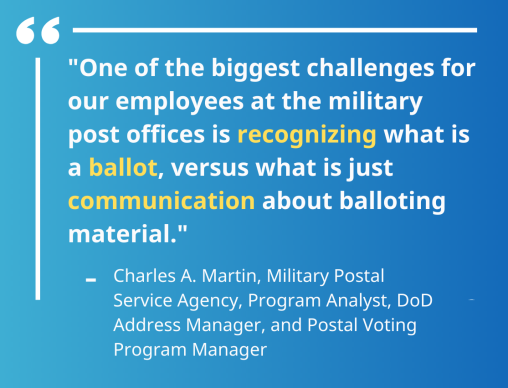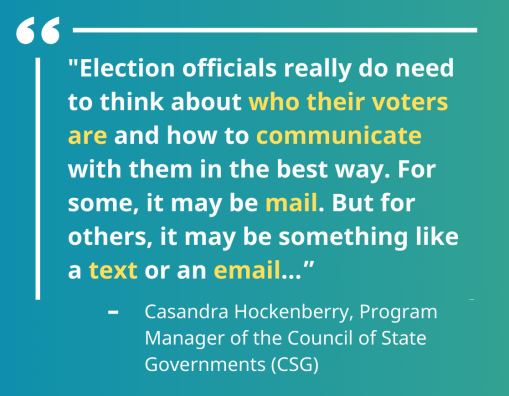
According to the 2020 Election Administration and Voting Survey (EAVS), the total number of registered Uniformed and Overseas Citizens Absentee Voting Act (UOCAVA) voters increased by about 69% from 2018. Over 1.2 million ballots were transmitted to military and overseas voters in 2020 with more than 900,000 returned and submitted for counting. This is a large increase for election officials to manage.
Below are six best practices election officials can use to support military and UOCAVA voters. These were highlighted by participants during the EAC’s recent public meeting on the subject.
Properly Identify Ballots Being Mailed to Military Voters
“One of the biggest challenges for our employees at the military post offices is recognizing what is a ballot, versus what is just communication about balloting material,” said Charles A. "Cam" Martin, Military Postal Service Agency, Program Analyst, DoD Address Manager, and Postal Voting Program Manager.
Mr. Martin said this is because there is nothing other than the writing on the envelope that identifies a blank ballot being mailed to voters. He added, “If both the incoming and outgoing envelopes would have some special marking or some sort of standard method of recognition for absentee ballots, that would assist, at least in the processing.”
J. Scott Wiedmann, Acting Director of the Federal Voting Assistance Program (FVAP), added, “Election officials should all work with their postal design specialist when they are designing the ballots to go out. And those are postage free. They used to be a pantone red color, but then in the last few years the post office has recommended everything be black ink on white paper to have the highest contrast.”
When Emailing Ballots to Military Voters, Understand the Possible Restrictions to Attachments and Hyperlinks
 UOCAVA voters are increasingly using electronic methods, such as email, to receive and return their ballots. “What we recommend election officials do is when they are sending the ballots out to military or overseas citizens as an attachment is to send a second email without an attachment just to say we just sent you your ballot by email to this email address,” said Acting FVAP Director Wiedmann.
UOCAVA voters are increasingly using electronic methods, such as email, to receive and return their ballots. “What we recommend election officials do is when they are sending the ballots out to military or overseas citizens as an attachment is to send a second email without an attachment just to say we just sent you your ballot by email to this email address,” said Acting FVAP Director Wiedmann.
In that second email without the ballot attachment, he recommends election officials include language asking them to check their spam folder, and if necessary, provide an alternative email address in case military voters do not see their ballot in their inbox.
If election officials are emailing ballots using a hyperlink, Acting Director Wiedmann says to keep in mind that emails sent within the Department of Defense are disabled. Make sure to include the entire URL in case a military voter needs to copy and paste it into their browser.
Use Standardized Addresses When Mailing Ballots Overseas
According to Mr. Martin, the addresses included on ballots that come across the Military Postal Service Agency are often out of date or undeliverable as addressed. He says this could be due to service members not being familiar with the standardized address format or forgetting to update their address when they moved to another location.
He encourages election officials to view the programs that USPS provides to clean up voter rolls and create standardized addresses. In fact, Mr. Martin explained that the easiest way to find a standardized address is by using the ZIP code tool available on usps.com. This tool will also check to see if the address is valid.
Don’t Wait Until UOCAVA Saturday to Send Ballots Out
The MOVE Act requires states to send absentee ballots to UOCAVA voters at least 45 days before federal elections, also known as UOCAVA Saturday. However, Paul Lux, Supervisor of Elections in Okaloosa County, Florida, stressed there is no prohibition on mailing them earlier.
“Beat that deadline as absolutely fast as you can,” said Mr. Lux, who serves a military population comprising approximately one-fifth of the county’s registered voters. He said his office typically sends military ballots 55 to 60 days ahead of federal elections. With that preparation, he suggests creating an alternate ballot in case a military voter is operating under restrictions that do not allow them to open the original ballot you sent.
When Communicating to Military Voters, Use Jargon-Free Language
 Clear communication is vital to ensuring that voters understand how and when to vote and UOCAVA voters are no exception. Karen Brinson Bell, Executive Director of the North Carolina State Board of Elections, says her office’s website is a central way they communicate to military voters.
Clear communication is vital to ensuring that voters understand how and when to vote and UOCAVA voters are no exception. Karen Brinson Bell, Executive Director of the North Carolina State Board of Elections, says her office’s website is a central way they communicate to military voters.
“If it’s complex and you’re deployed and only have a limited amount of time, you don’t need a webpage that’s page upon page long to try to figure out what to do,” said Executive Director Brinson Bell. Instead, she suggests keeping instructions short and jargon-free with simple, user-friendly language.
Mr. Lux says one way the election office he oversees in Okaloosa County, Florida, communicates with voters is through social media. “This is not just for my military members who may or may not be following my Facebook page,” said Mr. Lux. “But their family members that are there in the county who say, hey, by the way, your ballot was just mailed, so be on the lookout for it. They may have more of an opportunity to talk to the voter than we do.”
Ultimately, it is most important to use a communications method that servicemen and women will see. Casandra Hockenberry, Program Manager of the Council of State Governments (CSG), said that after speaking with the Service Level Voting Action Officer for the Marine Corps, the CSG found that the voting officer works with his servicemembers through text.
“Election officials really do need to think about who their voters are and how to communicate with them in the best way,” said Ms. Hockenberry. “For some, it may be mail. But for others, it may be something like a text or an email around deadlines and requirements. Voters sometimes don’t read the entire set of instructions, so making sure that we’re also highlighting some of those key points is important.”
Ensure Military and UOCAVA Voters Can View Your Election Office Website When Overseas
In some cases, Acting FVAP Director Wiedmann says, military and UOCAVA voters may not be able to access election office websites. “Whoever has the control over the IT infrastructure for that county, may, out of an abundance of caution, block some foreign IP addresses or foreign access,” said Acting Director Wiedmann. “This may inadvertently block either military or overseas voters from being able to get to that local jurisdiction’s website.”
This could especially be an issue if these voters are trying to visit an election office website to find out how to vote or to see if their ballot was counted. As a solution, he suggests that election officials work with their IT departments to create a whitelist to ensure that those voters are still able to get access.
Additional Resources for Serving Military and UOCAVA Voters
For more best practices on supporting military and UOCAVA voters, check out the following EAC resources:
- Pocket Guide for Serving Military and Overseas Voters;
- Fact sheet for election officials on UOCAVA and federal resources, their responsibilities as election officials, general considerations for residency, and information on federally prescribed forms;
- An interactive map showing differing state policies for residency requirements, FPCA electronic return availability, ability to use the FWAB to register to vote, and availability of electronic ballot return. This map can be found at eac.gov/uocava.
- Visit FVAP.gov for information on registering and casting a ballot.
Additionally, you can watch the livestream recording of the EAC’s public meeting on Supporting Military and UOCAVA Voters with the federal partners and state and local election officials featured in this blog post on the EAC’s YouTube channel.

